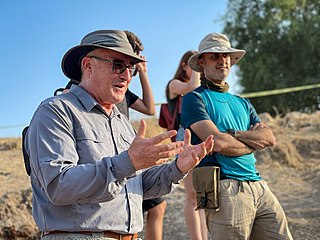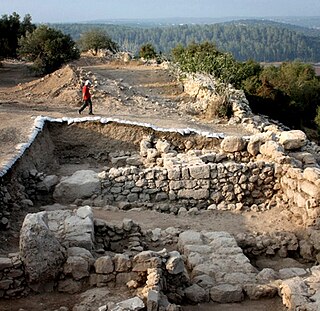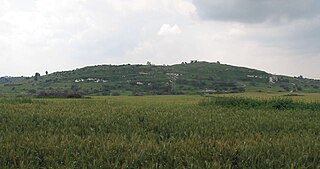Related Research Articles

The Philistines were an ancient people who lived on the south coast of Canaan during the Iron Age in a confederation of city-states generally referred to as Philistia.

Philistia was a confederation of five main cities or pentapolis in the Southwest Levant, made up of principally Gaza, Ashkelon, Ashdod, Ekron, and Gath, and for a time, Jaffa.

Ekron, in the Hellenistic period known as Accaron was a Philistine city, one of the five cities of the Philistine Pentapolis, located in present-day Israel.

Israel Finkelstein is an Israeli archaeologist, professor emeritus at Tel Aviv University and the head of the School of Archaeology and Maritime Cultures at the University of Haifa. Finkelstein is active in the archaeology of the Levant and is an applicant of archaeological data in reconstructing biblical history. Finkelstein is the current excavator of Megiddo, a key site for the study of the Bronze and Iron Ages in the Levant.

Gezer, or Tel Gezer, in Arabic: تل الجزر – Tell Jezar or Tell el-Jezari is an archaeological site in the foothills of the Judaean Mountains at the border of the Shfela region roughly midway between Jerusalem and Tel Aviv. It is now an Israeli national park. In the Hebrew Bible, Gezer is associated with Joshua and Solomon.

Gath or Gat was one of the five cities of the Philistine pentapolis during the Iron Age. It was located in northeastern Philistia, close to the border with Judah. Gath is often mentioned in the Hebrew Bible and its existence is confirmed by Egyptian inscriptions. Already of significance during the Bronze Age, the city is believed to be mentioned in the El-Amarna letters as Gimti/Gintu, ruled by the two Shuwardata and 'Abdi-Ashtarti. Another Gath, known as Ginti-kirmil also appears in the Amarna letters.

The Philistine language is the extinct language of the Philistines. Very little is known about the language, of which a handful of words survived as cultural loanwords in Biblical Hebrew, describing specifically Philistine institutions, like the seranim, the "lords" of the Philistine five cities, or the ’argáz receptacle, which occurs in 1 Samuel 6 and nowhere else, or the title padî.

The Israel Exploration Society (IES), originally the Jewish Palestine Exploration Society, is a society devoted to historical, geographical and archaeological research of the Land of Israel. The society was founded in 1913 and again in 1920, with the object of studying the history and civilization of the Land of Israel and of disseminating its knowledge.

Aren Maeir is an American-born Israeli archaeologist and professor in the Department of Land of Israel Studies and Archaeology at Bar-Ilan University. He is director of the Tell es-Safi/Gath Archaeological Project.

KhirbetQeiyafa, also known as Elah Fortress and in Hebrew as Horbat Qayafa, is the site of an ancient fortress city overlooking the Elah Valley and dated to the first half of the 10th century BCE. The ruins of the fortress were uncovered in 2007, near the Israeli city of Beit Shemesh, 30 km (20 mi) from Jerusalem. It covers nearly 2.3 ha and is encircled by a 700-meter-long (2,300 ft) city wall constructed of field stones, some weighing up to eight tons. Excavations at site continued in subsequent years. A number of archaeologists, mainly the two excavators, Yosef Garfinkel and Saar Ganor, have claimed that it might be one of two biblical cities, either Sha'arayim, whose name they interpret as "Two Gates", because of the two gates discovered on the site, or Neta'im; and that the large structure at the center is an administrative building dating to the reign of King David, where he might have lodged at some point. This is based on their conclusions that the site dates to the early Iron IIA, ca. 1025–975 BCE, a range which includes the biblical date for the biblical Kingdom of David. Others suggest it might represent either a North Israelite, Philistine, or Canaanite fortress, a claim rejected by the archaeological team that excavated the site. The team's conclusion that Khirbet Qeiyafa was a fortress of King David has been criticised by some scholars. Garfinkel (2017) changed the chronology of Khirbet Qeiyafa to ca. 1000–975 BCE.

Revadim is a kibbutz in southern Israel. Located in the southern Shephelah region, it falls under the jurisdiction of Yoav Regional Council. In 2022 it had a population of 830.

Philistine Bichrome ware is an archaeological term coined by William F. Albright in 1924 which describes pottery production in a general region associated with the Philistine settlements during the Iron Age I period in ancient Canaan. The connection of the pottery type to the "Philistines" is still held by many scholars, although some question its methodological validity.

Tell es-Safi was an Arab Palestinian village, located on the southern banks of Wadi 'Ajjur, 35 kilometers (22 mi) northwest of Hebron which had its Arab population expelled during the 1948 Arab–Israeli war on orders of Shimon Avidan, commander of the Givati Brigade.
Jeffrey R. Chadwick is an American professional archaeologist and university professor. He serves as Jerusalem Center Professor of Archaeology and Near Eastern Studies at the Brigham Young University Jerusalem Center in Israel, and as Associate Professor of Religious Education at Brigham Young University in Utah, USA. He is also a senior field archaeologist and director of excavations in Area F at the Tell es-Safi/Gath Archaeological Project in Israel.

The W. F. Albright Institute of Archaeological Research (AIAR) is an archaeological research institution located in East Jerusalem. It is the oldest American research center for ancient Near Eastern studies in the Middle East. Founded in 1900 as the American School of Oriental Research, it was renamed in 1970 after its most distinguished director and the father of biblical archaeology, William F. Albright. Its mission is to develop and disseminate scholarly knowledge of the literature, history, and culture of the Near East, as well as the study of civilization from pre-history to the early Islamic period.

The Ekron Royal Dedicatory Inscription, or simply the Ekron inscription, is a royal dedication inscription found in its primary context, in the ruins of a temple during the 1996 excavations of Ekron. It is known as KAI 286.

Tel Erani or Tell esh-Sheikh Ahmed el-ʿAreini is a multi-period archaeological site on the outskirts of Kiryat Gat in the Southern District of Israel. It is also known by the name ʻIrâq el-Menshiyeh, although thought to have borne the original Arabic name of Menshiyet es-Saḥalīn. The tell was first occupied in the Chalcolithic period, but its most notable remains are from the Bronze Age and Iron Age, when it was the site of a substantial Philistine city with links to Egypt. It has been identified with the biblical cities of Libnah, Gath, Mmst, Eglon and Makkedah, but none of these identifications are certain. The city was destroyed in the 6th century BCE, possibly by the Babylonians. In the Persian period, it was the site of a temple. There are also signs of settlement in the Hellenistic, Byzantine, and Mamluk periods. The Palestinian village of Iraq al-Manshiyya was located at the foot of the tell until it was depopulated in the 1948 Arab–Israeli War.
Sidnie White Crawford is professor emerita of Classics and Religious Studies at the University Of Nebraska-Lincoln. She specializes in the Dead Sea Scrolls and Textual Criticism of the Hebrew Bible. She also taught at St. Olaf College and Albright College. She has also been a visiting professor at Boston College.
References
- ↑ Friedman, Matti (August 9, 2011). "Unearthing the Bible's bad guys: Excavation of Gath helps scholars paint a portrait of the ancient Philistines". The Washington Times.
- ↑ W. F. Albright Institute of Archaeological Research. "W. F. Albright Institute of Archaeological Research Page". AIAR.
- ↑ UBToday. "Alumni Profile".
- ↑ IMDb. "I Like Mike". IMDb .
- ↑ katzcenterupenn. "Seymour (Sy) Gitin". Herbert D. Katz Center for Advanced Judaic Studies. Retrieved 2020-07-29.
- ↑ ed. D.R. Clark and V.H.. Matthews. "TEL MIQNE-EKRON - WF Albright Institute of Archaeological Research, pp. 57–85 in 100 Years of American Archaeology in the Middle East" (PDF). American Schools of Oriental Research. Archived from the original (PDF) on 2015-06-01.
{{cite web}}:|last=has generic name (help) - ↑ Gitin, Seymour. Recent Excavations in Israel: Studies in Iron Age Archaeology. Eisenbrauns. ISBN 9780897570497.
- ↑ Zuckerman, S., Late Bronze Age Scoops: Context and Function. In: S. Crawford, A. Ben-Tor, J.P. Dessel, W.G. Dever, A. Mazar, and J. Aviram (eds.) (2007). "Up to the Gates of Ekron": Essays on the Archaeology and History of the Eastern Mediterranean in Honor of Seymour Gitin. ASOR and IES Publications.
{{cite book}}:|last=has generic name (help)CS1 maint: multiple names: authors list (link) - ↑ Seymour Gitin, Trude Krakauer Dothan, Mark W. Meehl, Alexander Zukerman (2006). Tel Miqne-Ekron Excavations, 1995-1996: Field INE East Slope, Iron Age (Early Philistine Period). W.F. Albright Institute of Archaeological research and Institute of Archaeology, Hebrew University of Jerusalem. ISBN 9789657114018.
{{cite book}}: CS1 maint: multiple names: authors list (link) - ↑ MAUGH II, THOMAS H. (March 13, 1997). "Archeologists Rewriting Definition of a Philistine". Los Angeles Times.
- ↑ Wilford, John Noble (July 23, 1996). "Inscription at a Philistine City Shows: This is the Right Place". The New York Times.
- ↑ Aubet, Maria Eugenia (2007). White Crawford, Sidnie; Ben-Tor, Ammon; Dessel, J. P.; Dever, William G.; Mazar, Amihai; Aviram, Joseph (eds.). "Up to the Gates of Ekron": Essays on the Archaeology and History of the Eastern Mediterranean in honor of Seymour Gitin. Jerusalem: W.F. Albright Institute of Archaeological Research and the Israel Exploration Society. p. 509. ISBN 9789652210661.
- ↑ Gitin, Seymour (Mar–Apr 1990). "Ekron of the Philistines, Part II: Olive-Oil Suppliers to the World". BAR Magazine. Archived from the original on 2010-01-29. Retrieved 2012-05-10.
- ↑ Archeology. "Special Report: Ekron Identity Confirmed".
- ↑ “Up to the Gates of Ekron” ( 1 Samuel 17:52) Essays on the Archaeology and History of the Eastern Mediterranean in Honor of Seymour Gitin. eds. S.W. Crawford, A. Ben-Tor, J.P. Dessel, W. G. Dever, A. Mazar, and J. Aviram W.F. Albright Institute of Archaeological Research and Israel Exploration Society: Jerusalem